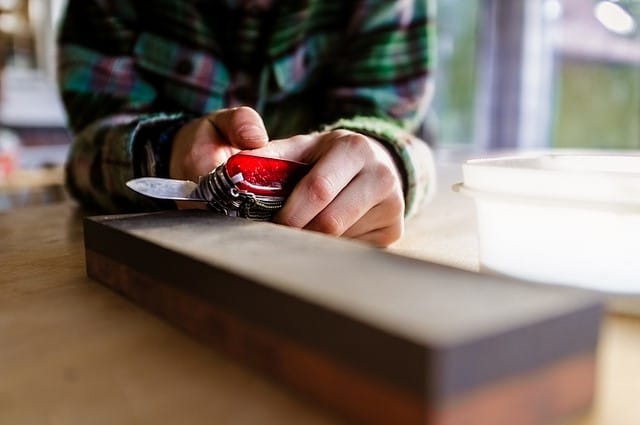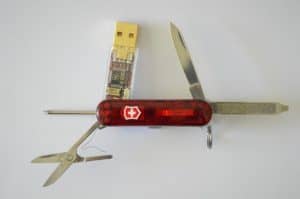
We don’t get too many guest posts here at Amazing Outdoor Adventures, and when we do give someone a shot we let them know just how important it is to us for the content we share to be outstanding. We value our readers and we don’t want to betray the trust they have put in us.
So without any further wait, here’s Irvan’s exceptional guest post:
“Just get the one that looks bad ass!” That’s what my mate told me when we were researching pocket knives. The truth is that bad ass doesn’t always cut it. That’s not to say you can’t find a sick looking pocket knife that functions just as well. As with anything you desire, you’ll have to do some homework to find something that best suits your specific needs.
To help you get started, here are 8 things you should consider before buying a pocket knife!
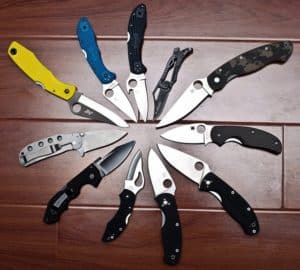
Table of Contents
Does Size Matter?
What does size mean to you? Pocket knives come in all sorts of shapes and sizes; credit card knives small enough to fit in your wallet, to Swiss Army multi-tools that can be carried pretty much everywhere. There’s also a range of large folders that can be stored in a sheath on your belt.
If you’re unsure of what size to get, spend some time thinking about what you’ll use the knife for.
Pocket knives can be used for just about anything. Some people use them for hunting, camping, or fishing. Others have one as an everyday carry (often referred to as EDC). You could also have one stashed in your emergency kit or stowed in your car glove box. If you have a good idea of what you’ll use your pocket knife for, you can select a size accordingly.
For example, if you’re a camper, a smaller option might be the best choice because of storage constraints. Maybe size isn’t a constraint if you’re stashing one away in an emergency kit.
Definitely worth giving it some thought, though…
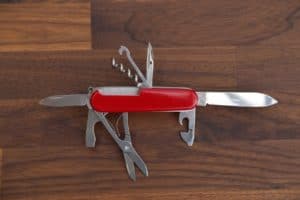
Traditional Folder Or Multi-tool?
Many enthusiasts swear by their decade old Swiss Armies, and will pledge to use nothing else. On the other side of the fence, there are those who swear by their traditional folders.
Which one is better? Hell, I will stay far far away from even attempting to answer that question!
The truth is it really depends on what you’re looking for. Multi-tools, I find are great for camping, fishing, and even hiking trips, and that’s because of the versatility they offer (typically they come with bottle openers, wire cutters, mini-saws etc.). The Swiss Army Knife is the classic example of these multi-tool sort of knives that many of us grew up with as boys and if you were in the Scouts, chances are one of your first knives was a simplified version of the Swiss Army knife followed by a closer to full version.
Folder knives are generally much more focused. They have a single blade that’s awesome at doing one specific thing.
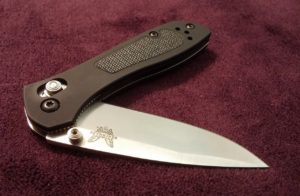
If you’re looking to whittle, saw, skin, carve, open bottles and cut wires, then a single blade traditional folder is probably not the right choice. These are often called lockback knives, as most lock into place to give that extra support you need while cutting.
Traditional folders lack the versatility of multi-tools, but they do the one thing they’re supposed to really well.
Edge Type: Plain, Serrated, Or Combo?
Everyone’s owns a bread knife right? Go take a look at it right now. That’s a serrated edge, and the little curved indents are often referred to as serrations. A plain edge is well…plain! In other words, there are no indents. A combination edge is one that is both plain and serrated.
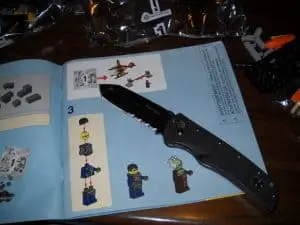
Okay, so how do you know which one to pick? Well, that depends on a couple things. Plain edges are great for push cuts, but not so great for pull cuts or saw type cuts. Serrated are great for pull cuts like cutting bread, but bad for push cuts.
Combos give you the best of both worlds.
Let’s talk sharpening for a moment. Serrated edges can be sharpened but they take time and require a tapered style sharpening rod. Plain edges are much much simpler to sharpen than their serrated counterparts.
Combo edges requires 2 stage sharpening: sharpening of the plain portion, followed by sharpening of the serrated portion. What’s the hardest to sharpen? Definitely the combos!
If you’re thinking of getting a combo edge, you better know how to sharpen, else you may be in for some serious disappointment when the edge dulls.
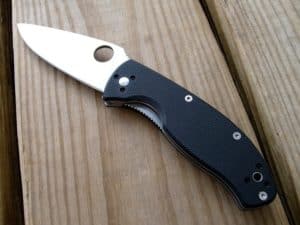
There is one more thing I’d like to mention about sharpening: certain manufacturers offer free lifetime sharpening (Spyderco is one such example), so this may be something you definitely wish to consider before buying. Don’t take this lightly!
Remember that a dull knife is not only useless, it’s dangerous. (Note from Site Admins: This is absolutely true. While it might seem counter-intuitive to someone relatively new to knives, this is an accurate statement)
If you don’t have a plan for sharpening or don’t know how, consider getting a knife from a manufacturer who will sharpen it for free, such as Spyderco. If you’re willing to learn the ropes and have the budget to invest in a sharpener (stone, electric etc.), then this may not be important.
Have You Thought About Steel?
The incredible never ending subject of knife steel. One could write a whole book on knife steel; the different types, how it’s forged, heat treatment, hardness, corrosion, and the list goes on and on. Don’t worry, I’ll spare you the song and dance in this post. However, there’s 2 important things you should know:
Edge Retention—As a rule of thumb and generally speaking, the harder the steel, the longer it will retain its edge, and therefore the less sharpening you’ll need to do. The opposite is true for a soft steel i.e. edge retention is shorter and as such, softer steels will require frequent sharpening. But…..there’s a caveat. Soft steels are easier to sharpen than hard steels, because they’re more malleable. It can be a little confusing, but it’s important to understand this. To make your life simple, the following steels are a great choice for beginners, as they’re easy to sharpen and can still retain an edge for some time:
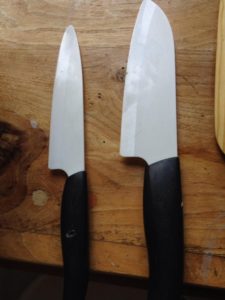
8CR13MOV—One of the best knife steels for a beginner. Also has great corrosion resistance.
14C28N—Slightly harder than 8CR13MOV. Long edge retention and good corrosion resistance.
420HC—One of the most corrosion resistant steels you can find! Also one of the easiest to sharpen because of how soft it is. A great beginner steel!
Here’s an informative write-up that talks about knife steel in great detail. It compares edge retention, corrosion resistance, and ease of sharpening for a variety of steels. I encourage you to give it a read! (all credit to Knife Informer).
Since I love confusing the heck out of you, here’s one more thing you need to remember: The more you increase hardness, you decrease toughness. What is toughness? To me it’s the beating a knife can take before it gets chipped or nicked. Low toughness means it will nick/chip easy; high toughness means it can take a couple knocks before it gets chipped.
What’s an example of a hard material with a low toughness? Ceramic! Ever held or used a ceramic knife before? If you have, you’ll know they’re bloody sharp, and they remain this way for long because of how hard ceramic is. The downside is they’re susceptible to nicks and chips.
All of this can be very confusing, so let’s summarize it all:
- Knife materials with high hardness (AKA increased Rockwell numbers) will retain an edge for long. The opposite is true for knife materials that are soft.
- Soft steels are easier to sharpen than hard steels, as soft steels are more malleable.
- Increase hardness in a material, and it’s toughness decreases. Increase toughness and hardness decreases.
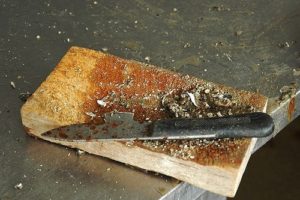
So what’s the best steel to have? One that’s very hard or very tough? The truth is it really depends on your specific needs. I like to have a moderately hard steel such as VG-10 for example. It retains an edge pretty well, is still fairly easy to sharpen, and is also reasonably tough.
If you’re a beginner, I suggest you stick with 8CR13MOV, 14C28N, or 420HC.
Corrosion
When choosing a knife steel, corrosion resistance is something you should always consider. There is no single steel that is impervious to corrosion. In other words, there’s no such thing as corrosion proof. Some steels are more corrosion resistant than others.
Generally speaking, the more chromium in steel, the more resistant to rust it will be. If you live in highly humid conditions or will be using your knife in a corrosive environment, you best consider a steel with high corrosion resistance.
Finally, the 3 things you’ll want to think about are hardness, toughness, and corrosion resistance. There’s tons of steels out there, and you’ll find review videos all over YouTube. Pick a steel that’ll work for what you need and roll with it!
Consider Purchasing A Sharpener!
I touched on this when talking about edge type in section 3, so I won’t say too much here other than this: start thinking about how you’re going to sharpen your dull blades from now! You have the following options:
- Use An Electric Knife Sharpener – If you can afford it, I recommend the Ken Onion by Work Sharp. By far the best electric knife sharpener at this time!
- Use A Pull Through Sharpener – Portable, cheap, and quick, but don’t expect a pull through to completely restore your edge. It’s a quick fix to get the job done.
- Use A Sharpening Stone – Choose from oil, water, or diamond stones. If you’re willing to learn the technique, stones are awesome. You can get a razor edge by using the right stones with good technique!

What About Locking Mechanism?
We could spend an entire post discussing pocket knife locking mechanisms! There’s a multitude of ways a knife can be locked, and every manufacturer has a preference. This is a topic that’s highly debated by knife aficionados.
But does locking mechanism really matter all that much? Should it be one of the main reasons you pick one knife over the other? In my honest opinion, no.
Locking mechanisms are important, but ultimately for what you need they should all work fine. Let’s look at two of the more common mechanisms below:
Liner Lock—Exactly as the name suggests, this is a type of mechanism where a liner locks and restricts a blade in place. What’s a liner? Basically a sheet of metal that sits between the blade and the handle.
Frame Lock—Exact same principle as the liner lock mechanism described above, with one major difference: A portion of the frame will slide up and lock the blade in place. Again, not too different from a liner lock.
Here’s an important piece of advice: when deciding on a locking mechanism, think about comfort. How does it feel when opening/closing? Are you left or right handed? Keep in mind some mechanisms are best suited for righties only! Finally, if you’re interested in knowing more about locking mechanisms, go check out the video below from Nick Shabazz.
https://www.youtube.com/watch?v=BfTSsNCielc
How Does It Feel?
An important consideration that often gets overlooked. If you’re like most people, you’ll probably research and buy online. The downside to this especially with knives, is you don’t get to actually hold and feel it in your hands. For those who don’t think so, yes it is a big deal! If it doesn’t feel good, all the other things don’t matter (edge, steel, locking mechanism etc.).
And this doesn’t just go for pocket knives, it goes for all knives! In my mind, how a knife feels is super important. Just like I won’t buy a pair of gloves that don’t fit my hands, similarly I won’t buy a knife that doesn’t feel right. Here’s the trade off: online is cheaper than offline/in-store.
Here’s what I suggest you do: decide on 3 to 4 knives online, and then see if you can get a feel for them in store. If you can, that’s awesome! If not, watch review videos on YouTube and see what others say. Hard to rely too much on one person’s experience because everyone is different, but it’s the best you can do!
$$$ How Much?
This one’s tough! Once you have considered everything from 1-7, you’ll want to determine just how much you’re willing to spend. In other words, set yourself a budget.
Now you may be wondering “What do I base my budget on?” and that’s a very good question. Here’s what I do: I decide on 1 through 7 discussed above, and then research. Anything that doesn’t fit my criteria is filtered out. All the knives that remain are what I base my budget on.
This usually ends up being about 10-15 knives. Now you should have a closer idea on the price range, and can decide how much you’re willing to spend. Here’s a post I wrote about 10 of my favorite pocket knives.
Feel free to check it out, if you wish!
Guest Author Bio:
Irvan manages the blog on myelectricknifesharpener where he writes about a variety of kitchen and knife related topics. Go check him out! Outside of knives and knife sharpening, Irvan enjoys playing/watching soccer, travelling to new countries, reading, and volunteering during his spare time. You can also follow him on Facebook by clicking here!
In Conclusion
Thanks again to Irvan for the awesome guest post! This is exactly the type of quality we want to see in a guest post, and it also hit an area that we haven’t covered nearly enough in our first two years: pocket knives and knives, which almost any outdoor enthusiast should be carry on them most of the time.
So we hope you liked this post and will give his site a visit. Thanks for reading, and make sure to find a good knife before heading out on your next outdoor adventure!
If you loved this article you may also be interested in these blog posts, as well:

